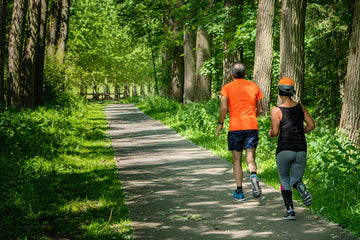A common symptom in stroke survivors is perceived heaviness of the legs. Alas, when your legs feel heavy, it may be challenging for you to adhere to your rehabilitation program. In this post, we explain more about this symptom and how to reduce heaviness in legs after a stroke.
According to this research paper, the sensation of heaviness in the legs after a stroke may be related to altered sensorimotor control, which could explain its association with fatigue. Previous theories suggested that heaviness in the legs following a stroke might be related to muscle weakness.
More research is needed in this area to get a stronger understanding of the heaviness in legs phenomenon. Thankfully, there are steps you can take to reduce the feeling of heaviness even without knowing for certain what causes it.
After a stroke, leg problems are common and can include weakness or paralysis on one side (hemiparesis), making walking difficult
Many stroke survivors experience spasticity—tight, stiff muscles that resist stretching and cause abnormal posture. Coordination issues often affect gait, resulting in foot drop (inability to lift the front part of your foot) or unstable walking patterns. Sensory changes like numbness or tingling may occur, increasing fall risk. Post-stroke fatigue can make mobility more challenging even when muscle strength is present.
Blood clots in leg veins (DVT) are a serious potential complication requiring immediate attention. Recovery typically involves physical therapy with targeted exercises to rebuild strength, improve balance, and retrain walking patterns. Assistive devices like ankle braces, canes, or walkers may help with mobility while recovering. Most improvement occurs in the first 3-6 months, but progress can continue with consistent rehabilitation.
Along with the muscles of the legs and feet, the Heart and Stroke Foundation of Canada reports that the muscles of the hands and arms may be affected by stroke. So, your arms may also feel heavy after a stroke, just like your legs.
Along with the feeling of heaviness, you may get tightness n your muscles since they can shorten.
One of the best ways to reduce the feeling of heaviness in legs after a stroke is to exercise. You should start out by performing some simple but effective stretches, after which you will be able to move on to aerobic workouts.
Some simple leg stretches and strengthening exercises you can try include ankle dorsiflexion, clams, heel raises, knee extensions, leg lifts, calf raises and more.
Downward dog is one of the most popular yoga poses, and it is one that can provide you with a great stretch after a stroke.
To enter this position, start by sitting on your hands and knees. Keep your hands on the floor, and lift your knees up off the ground, straightening your legs so that your hips are raised above you, and your body forms a triangle with the floor.
If you find downward dog useful, you may wish to check out other yoga stretches as well. This study found that stroke patients who practiced yoga were more active and had a higher quality of life than those who did not.
Another stretch that works well for stroke patients is the couch stretch. This stretch can be a bit challenging to describe. Basically, you place one foot on the floor. Place your opposite knee on the cushion of a couch, bending your leg back behind you so that your foot is resting on top of the couch back.
There are many variations on the couch stretch, some of which use a chair or a wall instead of a couch, so experiment and find what works best for you.
Once you have started doing some of the stretches above, you may be ready to progress to some light aerobic exercises. Here are a few options that can help you recover after a stroke.
Research shows that chronic stroke patients can improve their balance and gait with stationary cycling. You can also try stationary cycling, or even getting outdoors on a bicycle, to improve your leg heaviness. Just make sure you are balanced enough to not topple over before you hop on a real bicycle.
Jogging or running can help you to recover strength and endurance following a stroke, so these can be effective leg exercises for post-stroke leg heaviness. If you are not ready to jog or run yet, try just going on a brisk walk.
Learning how to walk after a stroke involves multiple challenges. We have already talked about leg heaviness, muscle weakness, and difficulties with balance. Around 10% of patients may experience chronic pain after a stroke. That includes pain from spasticity, shoulder subluxation, and peripheral neuropathy, which can affect the hands and feet.
In addition, around 20% to 30% of stroke patients have foot drop or inversion, where it is not possible to fully lift the feet while walking. When you cannot lift the fronts of your feet in a natural way, it is difficult to maintain a natural gait.
Despite these challenges, walking is important when you are recovering from a stroke. Research shows that patients who walk vigorously are able to improve their walking capacity in just 4 weeks, with additional gains over the next 8 weeks.
We will discuss how you can get back to walking safely and effectively shortly.
Current research does not provide clear support for swimming as an exercise for stroke rehabilitation. Nevertheless, many stroke patients find swimming enjoyable. And, as it does not require balance, it may be a safer exercise (with a lower risk of falling) than some alternatives.
One of the best things you can do to reduce leg heaviness and restore function to your limbs is to exercise, as has been our focus in this post. But how do you overcome the challenges that make it so difficult to exercise after a stroke?
When it comes to exercising outside of your home, what can make a big difference is to replace your regular shoes with shoes that are specifically designed for patients with stroke, peripheral neuropathy, and other health conditions that adversely impact gait.
The Cadense Original Adaptive Shoe is a shoe that features patented variable friction technology. This feature lets the wearer “glide” over uneven surfaces without fully lifting their foot. That means that stroke survivors who are experiencing foot drop can clear obstacles more easily, with less likelihood of tripping and falling.
These shoes are made out of lightweight materials, minimizing fatigue. This, too, is essential for recovering stroke patients, who may be prone to fatigue even with relatively modest levels of activity.
Cushioning and snug support help to keep ankles aligned and feet as comfortable as possible while standing or walking, which may help to alleviate any chronic or acute pain that you are experiencing following a stroke.
Finally, you can step into these shoes easily, and take them off just as easily. This can be a big help if you are experiencing any post-stroke muscle weakness or neuropathy in your hands along with your feet.
Shop our full collection of shoes for stroke patients. Our shoes are available in a range of colors so you can find the right fit not just for your feet, but also for your wardrobe.





![[color: black] Original Men's Adaptive Shoe](http://cadense.com/cdn/shop/files/Mens-BLK-T1-LG.jpg?crop=center&height=300&v=1765338442&width=300)
![[color: white] Original Women's Adaptive Shoe](http://cadense.com/cdn/shop/files/Womens-WHT-T1-LG.jpg?crop=center&height=300&v=1765381322&width=300)





